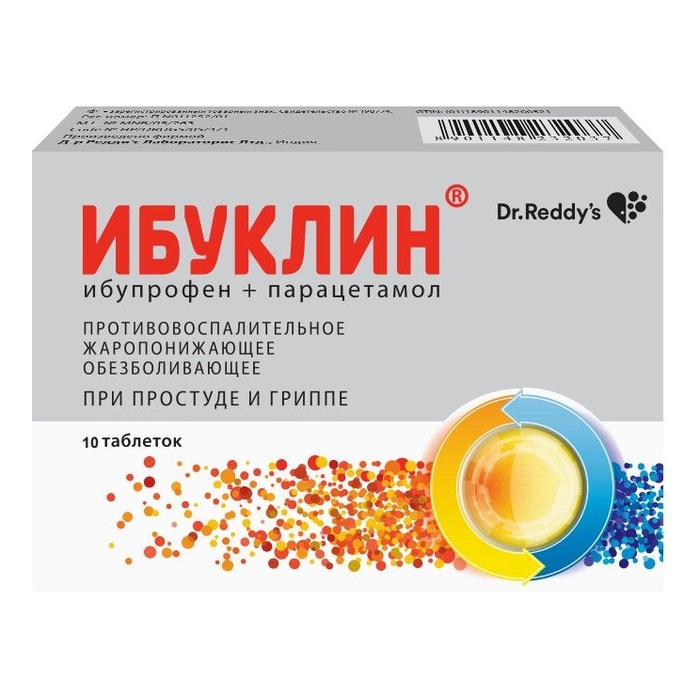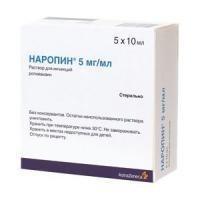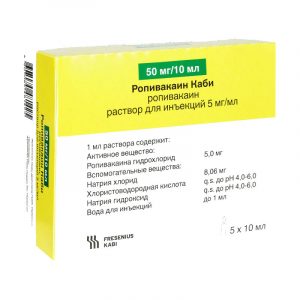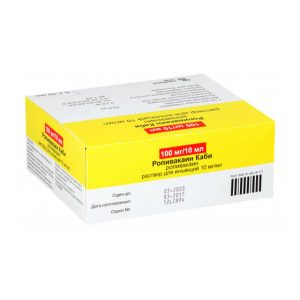Description
Release form
tablets
Packing
10 pcs.
Pharmacological action
Pharmacodynamics
Combined drug, the effect of which is due to its constituent components.
Ibuprofen is a non-steroidal anti-inflammatory drug (NSAID), has an analgesic, anti-inflammatory, antipyretic effect. Inhibiting cyclooxygenase (COX) 1 and 2, disrupts the metabolism of arachidonic acid, reduces the number of prostaglandins (mediators of pain, inflammation and hyperthermia), both in the focus of inflammation and in healthy tissues, suppresses the exudative and proliferative phases of inflammation.
Paracetamol – indiscriminately blocks COX, mainly in the central nervous system, weakly affects the water-salt metabolism and the mucous membrane of the gastrointestinal tract (GIT). It has an analgesic and antipyretic effect. In inflamed tissues, peroxidases neutralize the effect of paracetamol on COX 1 and 2, which explains the low anti-inflammatory effect.
The effectiveness of the combination is higher than the individual components. It weakens arthralgia at rest and during movement, reduces morning stiffness and swelling of joints, and contributes to an increase in range of motion.
Pharmacokinetics
Ibuprofen
Absorption – high, rapidly and almost completely absorbed from the digestive tract. Time to reach ma In inflamed tissues, peroxidases neutralize the effect of paracetamol on COX 1 and 2, which explains the low anti-inflammatory effect.
The effectiveness of the combination is higher than the individual components. It weakens arthralgia at rest and during movement, reduces morning stiffness and swelling of joints, and contributes to an increase in range of motion.
Pharmacokinetics
Ibuprofen
Absorption – high, rapidly and almost completely absorbed from the digestive tract. Time to reach ma In inflamed tissues, peroxidases neutralize the effect of paracetamol on COX 1 and 2, which explains the low anti-inflammatory effect.
The effectiveness of the combination is higher than the individual components. It weakens arthralgia at rest and during movement, reduces morning stiffness and swelling of joints, and contributes to an increase in range of motion.
Pharmacokinetics
Ibuprofen
Absorption – high, rapidly and almost completely absorbed from the digestive tract. Time to reach ma quickly and almost completely absorbed from the digestive tract. Time to reach ma quickly and almost completely absorbed from the digestive tract. Time to reach mamaximum concentration (TCmax) after oral administration – about 1-2 hours. Communication with plasma proteins – more than 90%. The half-life (T1 / 2) is about 2 hours. It slowly penetrates into the joint cavity, accumulates in the synovial fluid, creating higher concentrations in it than in blood plasma. After absorption, about 60% of the pharmacologically inactive R-form slowly transforms into the active S-form. It is metabolized. More than 90% is excreted by the kidneys (unchanged no more than 1%) and to a lesser extent with bile in the form of metabolites and their conjugates.
Paracetamol
Absorption is high, binding to plasma proteins is less than 10% and increases slightly with an overdose. Sulfate and glucuronide metabolites do not bind to plasma proteins even in relatively high concentrations. The value of Cmax is 5-20 μg / ml, TCmax is 0.5-2 hours. It is distributed fairly evenly in body fluids. Penetrates through the blood-brain barrier.
About 90-95% of paracetamol is metabolized in the liver to form inactive conjugates with glucuronic acid (60%), taurine (35%) and cysteine (3%), as well as a small amount of hydroxylated and deacetylated metabolites. A small portion of the drug is hydroxylated with microsomal enzymes to form highly active N-acetyl-n-benzoquinoneimine, which binds to the sulfhydryl groups of glutathione. With the depletion of glutathione in the liver (in case of an overdose), the enzyme systems of hepatocytes can be blocked, leading to the development of their necrosis.
T1 / 2 – 2-3 hours. In patients with cirrhosis of the liver, T1 / 2 is slightly increased. In elderly patients, the clearance of the drug decreases and T1 / 2 increases. It is excreted by the kidneys mainly in the form of glucuronide and sulfate conjugates (less than 5% – unchanged).
Less than 1% of the accepted dose of paracetamol
passes into breast milk. In children, the ability to form conjugates with glucuronic acid is lower than in adults.
and degenerative diseases of the musculoskeletal system
pain with bruises, sprains, dislocations, fractures
post-traumatic and postoperative pain
toothache
algodismenorea (painful struatsiya).
The drug is intended for symptomatic therapy, reduce pain and inflammation at the time of use, does not affect the progression of the disease.
Contraindications
Increased individual sensitivity to the components of the drug (including other NSAIDs).
Erosive and gastrointestinal ulcer diseases (including gastric and duodenal ulcer, Crohn’s disease, ulcerative colitis) or ulcerative bleeding in the active phase or in history (two or more confirmed episodes of peptic ulcer or peptic ulcer bleeding).
Cerebrovascular or other bleeding.
Hemophilia or other bleeding disorders (including hypocoagulation), hemorrhagic diathesis, intracranial hemorrhage.
Severe renal failure (creatinine clearance (CC) less than 30 ml / min).
Complete or incomplete combination of bronchial asthma, recurrent nasal polyposis and paranasal sinuses, and intolerance to acetylsalicylic acid or other NSAIDs (including a history of).
Severe heart failure (Class IV, NYHA classification of cardiologists).
Uncompensated heart failure.
Lesions of the optic nerve.
Genetic absence of glucose-6-phosphate dehydrogenase.
Diseases of the blood system.
The period after coronary artery bypass grafting.
Progressive kidney disease.
Severe liver failure or active liver disease.
Confirmed hyperkalemia.
Pregnancy (III trimester).
Children under 18 years old.
Precautions: Coronary heart disease, chronic heart failure, peripheral arterial disease, arterial hypertension, blood diseases of unknown etiology (leukopenia and anemia), cerebrovascular disease, dyslipidemia / hyperlipidemia.
History of a single episode of gastric and duodenal ulcer or gastrointestinal ulcer, Helicobacter pylori infection, gastritis, enteritis, colitis, history of ulcerative colitis.
Viral hepatitis, moderate to mild liver failure, benign hyperbilirubinemia (Gilbert, Dubin-Johnson and Rotor syndrome), cirrhosis of the liver with portal hypertension.
Renal failure, including dehydration (CC less than 30-60 ml / min), nephrotic syndrome.
Bronchial asthma or allergic diseases in the acute stage or in the anamnesis – the development of bronchospasm is possible.
Systemic lupus erythematosus or mixed connective tissue disease (Sharp syndrome) – increased risk of aseptic meningitis.
Chicken pox, severe somatic diseases, diabetes.
Concomitant use of other NSAIDs, oral glucocorticosteroids (including prednisone), anticoagulants (including warfarin), antiplatelet agents (including acetylsalicylic acid, clopidogrel), selective serotonin reuptake inhibitors (including serotoxin, paroxylinetram, citaloxetram, )
old age, smoking, alcoholism.
Pregnancy I-II trimester, period of breastfeeding.
Use during pregnancy and lactation
In the I and II trimester of pregnancy, the use of the drug Ibuklin ® is possible only as prescribed by the doctor in cases where the potential benefit outweighs the potential risk to the mother and potential risk to the fetus. The use of the drug in the III trimester of pregnancy is contraindicated.
If you need to use the drug during breastfeeding, you should stop breast-feeding.
In experimental studies, the embryotoxic, teratogenic and mutagenic effects of the components of the drug Ibuklin ® have not been established.
Before using Ibuklin ®, if you are pregnant or suspect that you might be pregnant, or plan to become pregnant, you should consult your doctor.
Special instructions
It is recommended that the drug be taken with the shortest possible course and the minimum effective dose necessary to eliminate the symptoms.
In patients with bronchial asthma or allergic diseases in the acute stage, as well as in patients with a history of bronchial asthma / allergic disease, the drug can provoke bronchospasm.
The use of the drug in patients with systemic lupus erythematosus or mixed connective tissue disease is associated with an increased risk of developing aseptic meningitis.
Patients with hypertension, including a history of and / or chronic heart failure, it is necessary to consult a doctor before using the drug, since the drug can cause fluid retention, increased blood pressure and swelling. Patients with uncontrolled arterial hypertension, NYHA class II-III congestive heart failure, coronary heart disease, peripheral arterial disease and / or cerebrovascular disease should be prescribed ibuprofen only after a careful assessment of the benefit-risk ratio, and the use of high doses of ibuprofen should be avoided ( 2400 mg / day).
NSAIDs in patients with chickenpox may be associated with an increased risk of developing severe purulent complications of infectious and inflammatory diseases of the skin and subcutaneous fat (e.g., necrotizing fasciitis). In this regard, it is recommended to avoid the use of the drug for chickenpox.
Information for women planning a pregnancy: the drug suppresses COX and prostaglandin synthesis, affects ovulation, disrupting female reproductive function (reversible after drug withdrawal).
The simultaneous use of the drug with other medicines containing paracetamol and / or non-steroidal anti-inflammatory drugs should be avoided. When using the drug for more than 5-7 days, according to the doctor’s prescription, peripheral blood parameters and the functional state of the liver should be monitored.
With the simultaneous use of anticoagulants of indirect action, it is necessary to monitor the parameters of the blood coagulation system.
To avoid possible damaging effects on the liver, do not drink alcohol while taking the drug.
The drug can distort the results of laboratory tests for the quantitative determination of glucose, uric acid in blood serum, 17-ketosteroids (drug withdrawal is necessary 48 hours before the study).
During the treatment period, the patient should refrain from engaging in potentially hazardous activities that require increased attention and speed of psychomotor reactions.
Composition
Each film-coated tablet contains:
Active ingredients:
ibuprofen 400 mg and paracetamol 325 mg.
Excipients:
microcrystalline cellulose 120 mg,
corn starch 76 mg, glycerol 3 mg,
sodium carboxymethyl starch (type A) 7 mg,
silicon dioxide 5 mg colloid
talcum powder 8 mg,
magnesium stearate 6 mg.
Shell: hypromellose 6 cps 11.32 mg, dye sunny sunset yellow (E110) aluminum varnish 1.78 mg, macrogol-6000 2.2 mg, talc 4.06 mg, titanium dioxide 0.16 mg,
polysorbate-80 0.16 mg, sorbic acid 0.16 mg, dimethicone 0.16 mg.
Dosage and administration
Inside (before or 2-3 hours after a meal), without chewing, with plenty of water.
1 tablet 3 times a day. The maximum daily dose is 3 tablets.
Duration of treatment is not more than 3 days as an antipyretic and not more than 5 days as an anesthetic. Continuation of treatment with the drug is possible only after consulting a doctor.
If, after treatment, improvement does not occur or the symptoms worsen, or new symptoms appear, consult a doctor. Use the drug only according to the indications, the method of use and at the doses indicated in the instructions.
Side effects
Gastrointestinal disorders
NSAIDs gastropathy – nausea, vomiting, heartburn, anorexia, discomfort or pain in epigastrium, diarrhea, flatulence rarely – erosive and ulcerative lesions, bleeding impaired liver function, hepatitis, pancreatitis irritation or dry mouth, pain in the mouth, ulceration of the mucous membrane of the gums, aphthous stomatitis constipation. Peptic ulcer, melena, bloody vomiting, in some cases fatal, especially in elderly patients, gastritis, exacerbation of colitis and Crohn’s disease, increased activity of liver transaminases, jaundice.
Disorders of the nervous system and sensory organs
Headache, dizziness, insomnia, anxiety, nervousness, irritability, agitation, drowsiness, depression, confusion, hallucinations rarely – aseptic meningitis (more often in patients with autoimmune diseases) hearing loss, noise in ears, visual impairment, toxic damage to the optic nerve, blurred vision or double vision, scotoma, amblyopia.
Disorders of the cardiovascular system
Heart failure, peripheral edema, prolonged use increases the risk of thrombotic complications (eg, myocardial infarction), increased blood pressure, tachycardia.
Disorders of the blood and lymphatic system
Anemia (including hemolytic and aplastic), thrombocytopenia, thrombocytopenic purpura, agranulocytosis, leukopenia, pancytopenia.
Disorders of the respiratory system and mediastinal organs
Shortness of breath, bronchospasm, bronchial asthma.
Disorders of the kidneys and urinary tract
Allergic nephritis, acute renal failure, nephrotic syndrome, edema, polyuria, cystitis, hematuria, proteinuria, nephritic syndrome, papillary necrosis, interstitial nephritis.
Allergic reactions
Skin rash, skin itching, urticaria, Quincke’s edema, bronchospasm, dyspnea, allergic rhinitis, dryness and irritation of the eyes, conjunctival and eyelid edema, eosinophilia, fever, anaphylactic shock, Steven-formative exudative syndrome (EF) epidermal necrolysis (Lyell’s syndrome).
Laboratory indicators
Decreased serum glucose concentration, decreased hematocrit and hemoglobin, increased bleeding time, increased serum creatinine concentration.
Other
Strengthen sweating.
With prolonged use in high doses: ulceration of the mucous membrane of the gastrointestinal tract, bleeding (gastrointestinal, gingival, uterine, hemorrhoidal), visual impairment (color vision, scotoma, amblyopia).
If you have side effects indicated in the instructions or are aggravated, or you notice any other side effects not listed in the instructions, notify your doctor.
Drug Interactions
Reduces the effects of antihypertensive drugs and diuretics (by inhibiting renal PG synthesis).
Increases the concentration in the blood of digoxin, lithium and methotrexate preparations.
Caffeine enhances the analgesic effect of ibuprofen.
Cyclosporine and gold preparations increase nephrotoxicity.
Cefamandol, cefoperazone, cefotetan, valproic acid, plicamycin increase the incidence of hypoprothrombinemia.
Antacids and colestyramine decrease the absorption of the drug.
Myelotoxic drugs contribute to the manifestation of hematotoxicity of the drug.
When taken with acetylsalicylic acid, ibuprofen reduces its anti-inflammatory and anti-aggregation effects (it is possible to increase the incidence of acute coronary insufficiency in patients receiving small doses of acetylsalicylic acid as an anti-aggregation agent after taking ibuprofen).
Combination with ethanol, corticosteroids, corticotropin increases the risk of erosive and ulcerative lesions of the gastrointestinal tract.
Ibuprofen enhances the effects of direct (heparin) and indirect (coumarin and indandion derivatives) anticoagulants, thrombolytic agents (alteplase, anistreplase, streptokinase, urokinase), antiplatelet agents, colchicine – the risk of hemorrhagic complications increases.
Enhances the hypoglycemic effect of insulin and oral hypoglycemic drugs.
overdose
Symptoms: gastrointestinal disorders (diarrhea, nausea, vomiting, anorexia, epigastric pain), increased PV, bleeding after 12 48 h, drowsiness, drowsiness, depression, headache, headache, headache , cardiac arrhythmias, decrease in blood pressure, manifestations of hepatotoxicity and nephrotoxicity, convulsions, development of hepatonecrosis is possible.
If you suspect an overdose, you should seek immediate medical attention.
Treatment: gastric lavage for the first 4 h alkaline drink, forced diuresis appointment of activated carbon, administration of SH-group donors and precursor for glutathione – methionine synthesis – 8 9 h after overdose and N-acetylcysteine inside or in / after 12 h antacid drugs hemodialysis symptomatic therapy. The need for additional therapeutic measures (further administration of methionine, N / acetylcysteine injection) is determined by the concentration of paracetamol in the blood, as well as by the time elapsed after its administration.
Storage conditions
At a temperature not exceeding 25 ° C.
Keep out of the reach and sight of children!
Shelf life
5 years.
Deystvuyushtee substance
Ibuprofen, paracetamol
Pharmacy terms
Without a prescription
Dosage form
tablets
Indications
Indications
Indications
Indications
Indications
body, painful menstruation, myalgia, joint pain, neuralgia, bruises, SARS, headache, toothache
dr30d54 Dr. Reddy’s, India




